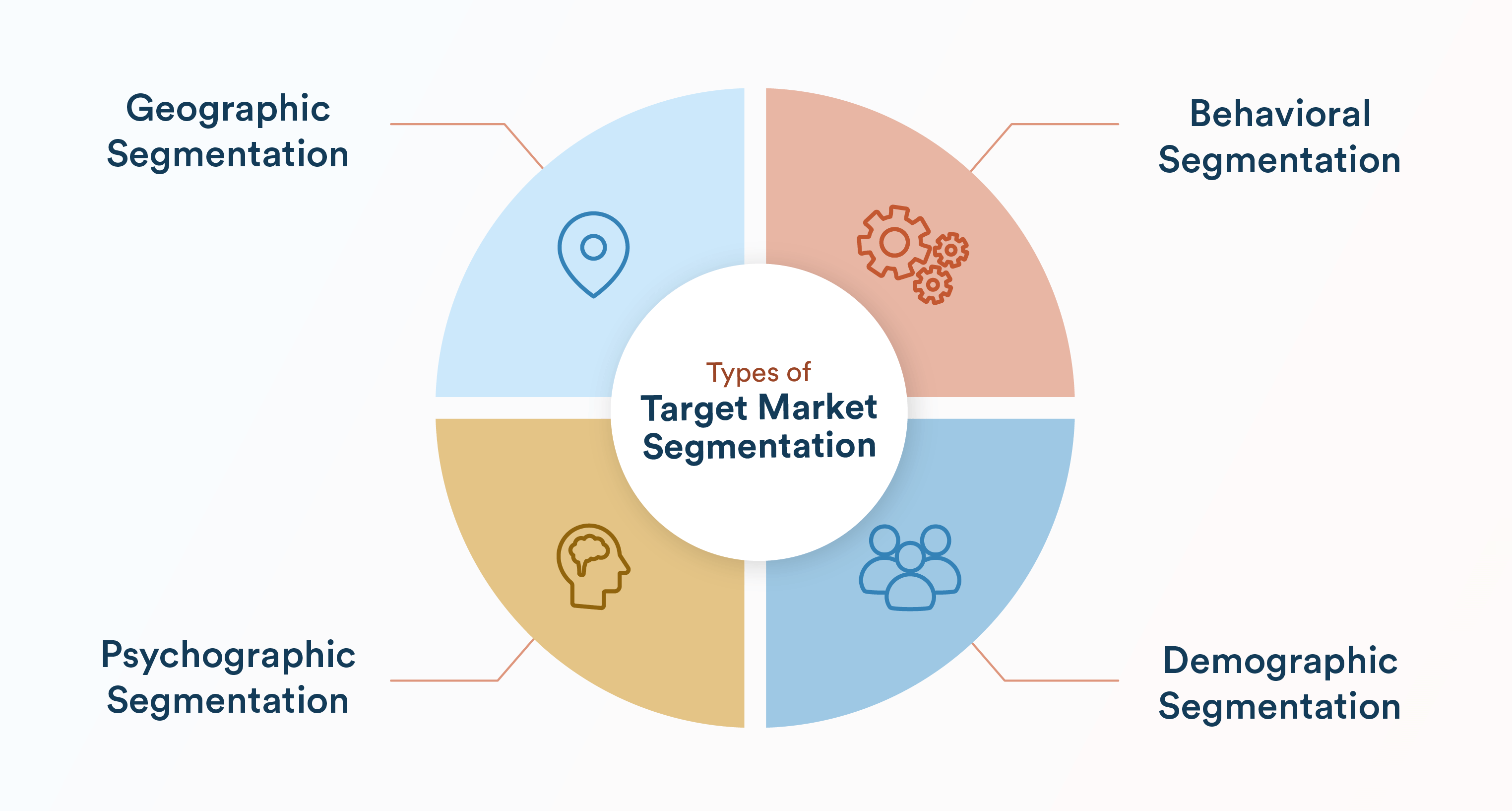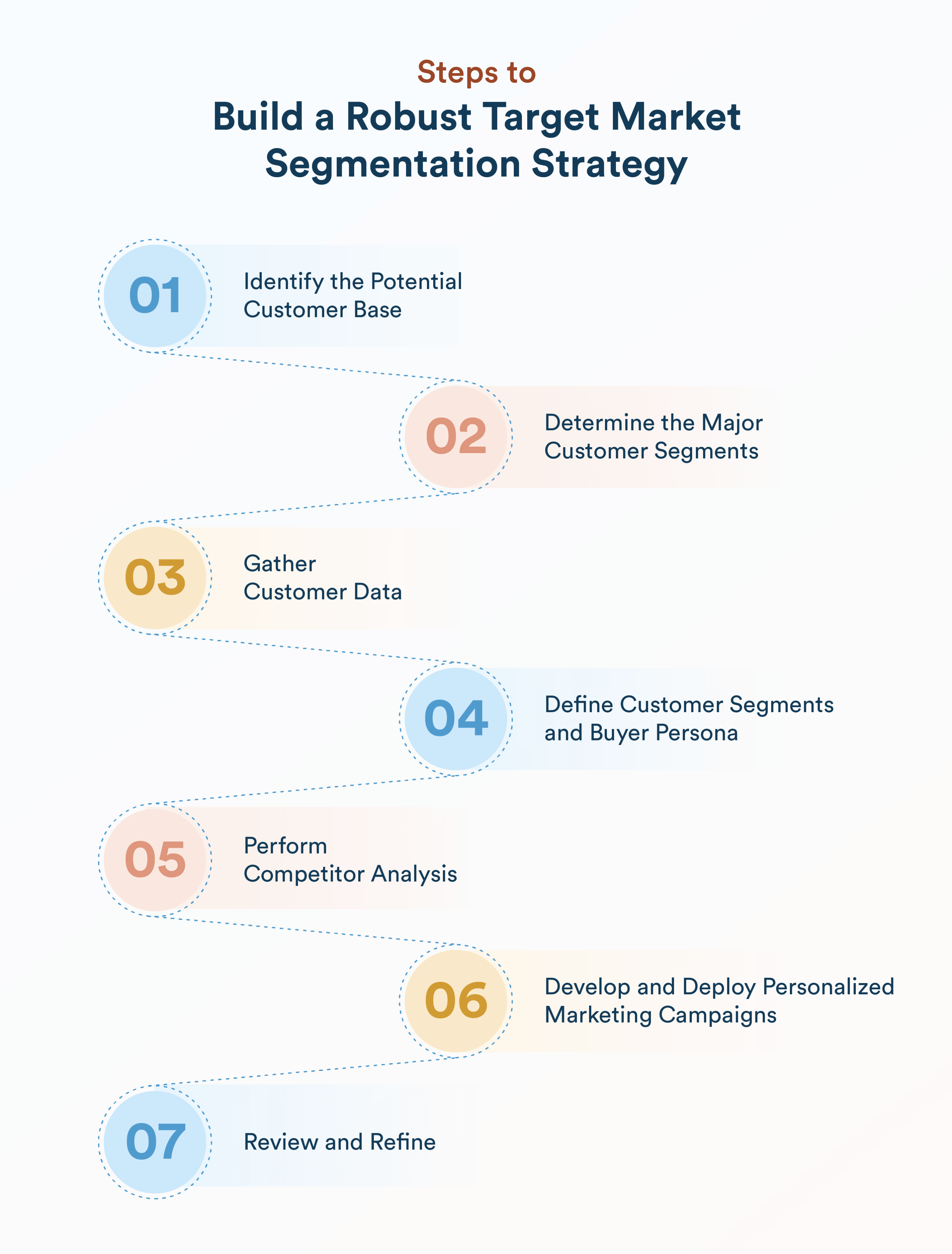Target market segmentation is a powerful tool that helps marketers unlock deeper customer understanding and unleash the true capabilities of personalization. This blog provides a detailed overview of target market segmentation, including its types, benefits, examples, steps to build an effective segmentation strategy, and more.
What is Target Market Segmentation?
Target market segmentation, or market segmentation, is the strategic process of classifying a broader target market into smaller groups with similar characteristics to manage them easily. It involves creating subsets of the target audience based on common traits such as age, gender, income, location, interests, preferences, and other factors.
Universal spray and pray campaigns that broadcast generic messages to large groups are no longer effective or efficient. To thrive in today’s hyper-competitive marketing landscape, you need to ditch the one-size-fits-all approach and use targeted marketing techniques. Customers expect brands to understand and cater to their distinctive needs and preferences by crafting and delivering experiences that resonate and provide value.
Segmenting the customer base into smaller cohorts enables you to better understand the audiences, tailor marketing campaigns, and promote products that effectively resonate with them, eventually boosting engagement, conversions, and customer lifetime value (CLV).
Types of Target Market Segmentation
Marketing segmentation can be approached from varied dimensions, depending on the set goals and customer data on hand. Listed below are a few of the most common categories of market segmentation.

Demographic Segmentation
Dividing users based on shared demographic data points, such as age, gender, marital status, education, and family size. This is a rudimentary approach that might not paint a clear or complete picture. For instance, targeting millennials solely depending on age might miss a significant segment that skews older or younger depending on the product or service. Demographic segmentation is usually coupled with other types of segmentation for a more effective grouping of customers.
You can use demographic segmentation to classify your customers based on:
- Age
- Gender
- Ethnicity
- Income
- Area of Residence
- Religion
- Education
- Occupation
- Marital Status
- Family Structure
- Years of Work Experience
Geographic Segmentation
Splitting users by location to target them with products or services based on geographical characteristics like country, state, city, or zip code. Geographic segmentation is particularly useful for brands with localized offerings or varying marketing regulations across regions. For example, the marketing efforts of a company selling winter wear will significantly differ in Miami from their campaigns in Alaska.
Geographic segmentation allows you to segment your audience by:
- Location
- Time zone
- Language
- Population density
- Culture
- Climate
Psychographic Segmentation
Grouping users based on psychological traits like values, interests, lifestyles, attitudes, and more. Psychographic segmentation can help you better understand customers’ tastes and preferences and tailor messaging and product recommendations that resonate with their specific mindsets. For example, a brand selling sports gear will target a segment that prioritizes health and fitness with campaigns that highlight the performance benefits of their products.
Psychographic segmentation involves grouping customers based on factors such as:
- Interests
- Habits
- Lifestyle
- Personality
Behavioral Segmentation
Sorting customers based on the behaviors they exhibit like past actions and interactions with the brand, purchase history, and campaign engagement. By closely monitoring and analyzing the users in each cohort, you will be able to pinpoint high-value users, forecast future behavior and actions, and personalize the customer journey for them accordingly.
For example, an e-commerce company might want to group customers by spending habits, session frequency, browsing history, average order value, and other such factors. A well-crafted behavioral segmentation strategy would enable you to target users with special offers or deals to nudge them toward a conversion.
Behavioral segmentation enables you to segment customers by:
- Action/inaction
- Spending/consumption habits
- Feature use
- Session frequency
- Browsing history
- Average order value
Benefits of Target Market Segmentation
When done right, target market segmentation can engender several benefits, enabling you to make the most out of your marketing strategy.
Better Product-Market Fit
Market segmentation provides invaluable insights into the needs and preferences of different customer groups. This helps you develop products and services that are aligned with customer needs and optimize costs by allocating resources to features that the users require.
Improved Targeting
Target market segmentation enables you to accurately define distinct customer segments to ensure that the marketing messages reach the correct set of people at an appropriate time. Such a laser-focused approach eliminates the waste on ad spend and maximizes ROI.
For instance, consider a brand selling athletic gear. They could segment their audience by sport (running, basketball, baseball, yoga) and tailor their marketing messages accordingly. This ensures that runners see promotions for running shoes and apparel, while cricket players are notified about cricket-specific products.
Increased Relevance
When marketing campaigns resonate directly with the needs and interests of the customers, they are bound to find value in them. Segmentation allows you to craft personalized messages and product recommendations with a higher likelihood of conversion. For example, an email listing products that prospective customers are genuinely interested in has more chances of conversion than a generic marketing blast that doesn’t pique their curiosity.
Better Engagement and Loyalty
Target market segmentation helps foster stronger customer relationships with a deep understanding of what the users need. For instance, a finance and investment company can leverage this strategy to group its customers by investment goals (retirement planning, college savings, wealth management, etc.) and provide them with appropriate investment opportunities that cater to their specific needs. By segmenting the audience, businesses can tailor their interactions for each group, fostering a sense of personalization and building brand loyalty.
Increased ROI
Brands can utilize their marketing budgets more efficiently by targeting specific segments with relevant campaigns and achieve a greater return on investment. For example, a music streaming service can segment its user base depending on their listening habits to promote new artists accordingly (pop enthusiasts, rock fans, etc.)
Improved Customer Lifetime Value
By catering to the specific needs and preferences of different customer segments, brands encourage repeat purchases and build long-term relationships with the users. Segmenting users by past purchases and history could prove to be useful while offering personalized product suggestions in the future increasing the chances of customer satisfaction and hence reducing the probability of churn.
Data-Driven Decisions
Market segmentation empowers you to leverage customer data to make better-informed strategic decisions, including determining the right product, price, promotional strategy, and distributional channel. It provides valuable insights by analyzing customer data within each segment, enabling you to refine and optimize campaigns for maximum impact.
How to Build a Robust Target Market Segmentation Strategy?
Target market segmentation strategy is the systematic process of identifying, analyzing, and targeting a specific customer segment from the overall target market. Every business develops a market segmentation strategy to create customer groups suitable for more targeted and personalized marketing campaigns.
Here are the steps that can help you develop the right market segmentation strategy for your business.

Identify the Potential Customer Base
First and foremost, you need to identify who needs your product or service. This is essentially the entire potential customer base to which your product appeals. It requires understanding what pain point or customer needs your product addresses. For example, for a streaming app, the potential customer base would include people from the Silent Generation to the Gen Alpha around the world.
Determine the Major Customer Segments
Within the broader customer base, identify the major customer segments. This requires basic customer information to understand their characteristics and identify the common ground to group them. In the streaming app example, major customer segments could be based on age, location, and so on.
Gather Customer Data
This step requires performing deeper research to collect customer information to get additional insights into their taste, preferences, and behaviors. Generally, companies collect basic information like age, gender, and address from new customers when they create their profile on their app or website.
That said, you can also fetch more information through surveys, analytics tools, and third-party demographic marketing data services that use browser cookies, buying history, and even social media. This will help you better define core customer segments, understand key trends, and test different and more relevant classifications.
Define Customer Segments and Buyer Persona
Leverage the customer data to define customer segments. This includes core customer segments that contribute the most to your business as well as potential segments that might have been overlooked but have the potential to generate new business. These segments could be defined using demographic, psychographic, geographic, or behavioral criteria or a combination of these.
At the same time, create a buyer persona for each segment, representing the prospective customer you need to target with your marketing efforts. Creating this buyer persona can help you break down the segments even further to identify niche segments that are most relevant to your business.
Perform Competitor Analysis
Understanding competitors’ strategies is a critical step in the target market segmentation process. It provides key insights into how your competitors are segmenting the customer pool, their pricing model, the tactics they are employing for their outreach initiatives, what strategies work for them, how you can set your product and message apart, and much more. This will help you bring in the element of uniqueness and ingenuity that can make your brand stand out and appeal the most to the target customers.
Develop and Deploy Personalized Marketing Campaigns
Develop marketing campaigns tailored for each of the market segments identified. This includes determining mediums or channels for maximum outreach, crafting messages that resonate with the target segment, creating offers that might influence underserved or unengaged segments to make a purchase, and more.
Review and Refine
Developing and deploying the market segmentation strategy is not a one-time activity. Various micro and macro factors, such as unexpected events like COVID-19 or natural disasters, seasonal changes, evolving customer behavior and preferences, new product launches, or changes in overall business focus and objective, can drive businesses to go back to the drawing board and create market segments that are more aligned and relevant to their evolving business requirements.
What’s important is to keep testing the target market segments and marketing campaigns and tracking their performance. This iterative process is essential to keep refining the strategy for continued business growth.
Explore in Depth: What are the Key Differences Between Target Market and Market Segmentation?
Target Market Segmentation Examples
Let’s understand how target market segmentation helps identify core customer groups and develop strategies to reach them with the help of some examples.
Example 1: Auto Manufacturing Company
Consider an auto manufacturing company, offering a range of cars – hatchbacks, sedans, and SUVs. It uses factors such as age, income, location, and preferences to identify the following core segments.
- Economical Buyers: This includes people in the age group of 18-30 years with annual household income under $250,000 and located in tier-1 and tier-2 cities. People in this segment usually prefer hatchbacks and seek safety features and practicality when making the purchase.
- Luxurious Buyers: This includes people in the age group of 30-60 years with an annual household income of over $250,000 and located in tier-1 cities. People in this segment usually prefer sedans and SUVs and seek exclusivity, high-end features, and unparalleled craftsmanship.
Now, if the company adds ‘family structure’ into the mix, it can create a new segment of “family-centric buyers”, who could belong to the age group of say 30-45 years and seek safety features and spaciousness in their cars. This segment can prefer hatchbacks or sedans, depending on the price point.
A new segment that has come up in recent years is the “eco-friendly buyers” who prefer electrical vehicles (EVs) or models with better fuel efficiency and lower carbon footprint.
The more customer data you have, the more refined your segmentation will be. Now, each of these segments should be targeted with messages and marketing communication that resonate the most with them. For example, to the family-oriented buyer, the company could highlight the sturdiness of the vehicle, safety features, good legroom, and other such features.
Example 2: Skincare Company
Consider a skincare company, offering a range of products for men and women such as face wash, moisturizing creams, sunscreens, serums, night creams, body lotion, and other products. It uses factors such as age and gender to create the following segments:
- Men: The company found that men across age groups mostly stick to basic skincare involving face wash and moisturizing cream. The market segmentation research undertaken by the company helped it understand not only what and how to market its products to this segment but also save resources that would have been otherwise wasted on products that don’t have a market yet.
- Women, 16-25 years: This is the market segment that is easily influenced by social media and influencers and wants to keep up with the latest trends in skincare. So, the company can collaborate with social media influencers to market its products with messaging highlighting the latest trends of even skin tone, glass skin, and more.
- Women, 25-40 years: This is the market segment that has a proper skincare regime, is largely aware of what ingredients are essential, and is primarily focused on anti-aging skincare. The company can use a combination of television, billboards, and social media marketing for its serums, anti-aging and night creams, and other products, highlighting key ingredients such as retinol and niacinamide, and messaging centered on reducing fine lines, wrinkles, dark spots, and so on.
- Women, 40-60 years: Women in this segment also have a proper skincare regime but usually stick to the products that have been working for them and are mostly repeat purchasers. Occasionally, they might consider trying out a new product. The company can use a combination of television, billboards, newspaper, and social media advertising for its products.
Read More: What is Customer Segmentation? The Complete Guide
How CleverTap Helps With Target Market Segmentation
To unlock the magic of personalization with marketing segmentation, consider using an all-in-one customer engagement platform like CleverTap. With CleverTap’s advanced segmentation capabilities and customer data management features, you can create micro-segments based on factors such as past behavior, real-time actions, and common properties. You can also create predictive segments based on the future action that users might take within your app and custom list segments, which allows you to ingest third-party data into CleverTap and run engagement for it. The Clever.AI segmentation model enables you to set engagement goals and get the probability of achieving those goals.
CleverTap empowers you to truly harness the power of segmentation to orchestrate bespoke marketing experiences that will leave the users in awe.
To learn more about how CleverTap can help you with target market segmentation, schedule a demo today!
Conclusion
To sum it up, target market segmentation is an important marketing strategy that can provide valuable insights into how you can boost business revenue by targeting specific customer groups. This customer-centric approach enables you to spend your dollar where it matters the most while increasing customer loyalty and retention.
Remember, segmentation is the captain that steers your brand toward success. So, start now, segment your audience, and personalize your marketing efforts to create an exceptional customer experience.
Subharun Mukherjee 
Heads Cross-Functional Marketing.Expert in SaaS Product Marketing, CX & GTM strategies.
Free Customer Engagement Guides
Join our newsletter for actionable tips and proven strategies to grow your business and engage your customers.















































